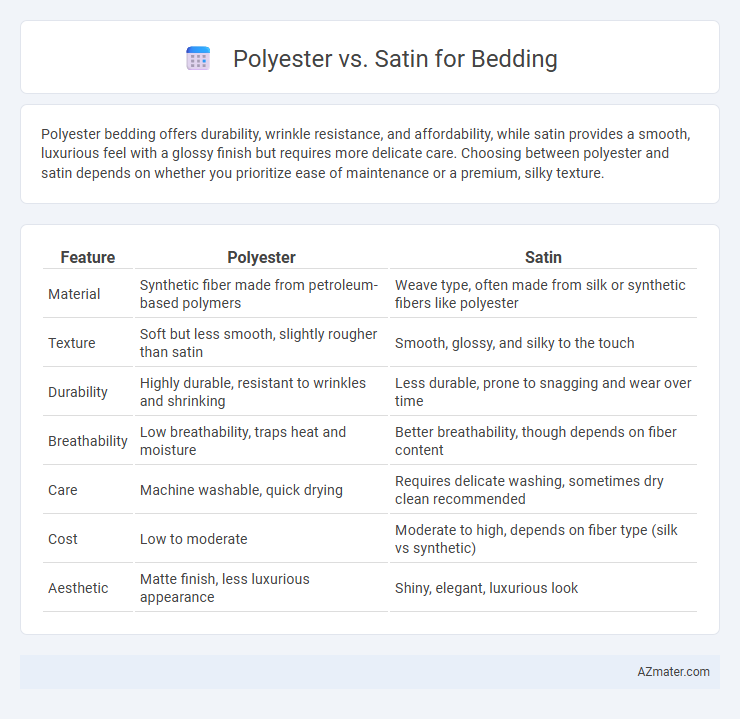Polyester bedding offers durability, wrinkle resistance, and affordability, while satin provides a smooth, luxurious feel with a glossy finish but requires more delicate care. Choosing between polyester and satin depends on whether you prioritize ease of maintenance or a premium, silky texture.
Table of Comparison
| Feature | Polyester | Satin |
|---|---|---|
| Material | Synthetic fiber made from petroleum-based polymers | Weave type, often made from silk or synthetic fibers like polyester |
| Texture | Soft but less smooth, slightly rougher than satin | Smooth, glossy, and silky to the touch |
| Durability | Highly durable, resistant to wrinkles and shrinking | Less durable, prone to snagging and wear over time |
| Breathability | Low breathability, traps heat and moisture | Better breathability, though depends on fiber content |
| Care | Machine washable, quick drying | Requires delicate washing, sometimes dry clean recommended |
| Cost | Low to moderate | Moderate to high, depends on fiber type (silk vs synthetic) |
| Aesthetic | Matte finish, less luxurious appearance | Shiny, elegant, luxurious look |
Introduction to Polyester and Satin Bedding
Polyester bedding features durable synthetic fibers known for wrinkle resistance, moisture-wicking capabilities, and affordability, making it a practical choice for everyday use. Satin bedding, crafted from silk, polyester, or nylon fibers, offers a smooth, glossy finish that enhances comfort and adds a luxurious aesthetic to bedrooms. Both materials impact sleep quality differently, with polyester providing easy care and satin excelling in softness and temperature regulation.
Material Composition: Polyester vs Satin
Polyester bedding is made from synthetic fibers derived from petroleum, offering durability, wrinkle resistance, and affordability. Satin, on the other hand, describes a weave pattern rather than a specific material and can be made from polyester, silk, or nylon, giving it a smooth, glossy surface and luxurious feel. Understanding that satin refers to the finish, while polyester is a fabric type, helps in choosing bedding that balances comfort, cost, and maintenance.
Texture and Feel: Comfort Comparison
Polyester bedding offers a smooth, slightly coarse texture that is durable and wrinkle-resistant, making it a practical choice for everyday use. Satin, typically made from silk or synthetic fibers like polyester, provides a luxurious, silky feel that glides effortlessly against the skin, enhancing comfort and reducing friction. While satin excels in softness and elegance, polyester stands out for its resilience and ease of maintenance in bedding applications.
Breathability and Temperature Regulation
Polyester bedding offers lower breathability and retains heat, making it less ideal for warm sleepers due to its synthetic fibers that trap moisture. Satin, often made from silk or a silk-like polyester weave, provides a smoother surface with slightly better airflow, enhancing temperature regulation for a cooler sleep experience. Choosing satin bedding can improve moisture wicking and reduce overheating compared to standard polyester options.
Durability and Longevity
Polyester bedding offers superior durability due to its synthetic fiber composition, making it resistant to wrinkles, shrinking, and stretching over time. Satin, often made from silk or polyester blends, provides a smooth and luxurious feel but can be less durable, especially if composed of delicate silk fibers prone to wear and tear. When prioritizing longevity, polyester satin blends may offer a balanced option, combining satin's softness with polyester's strength and resilience.
Maintenance and Care Instructions
Polyester bedding offers durability and stain resistance, requiring minimal maintenance with machine washing in warm water and low-heat tumble drying to prevent shrinkage. Satin bedding, often made from silk or polyester blends, demands gentler care such as hand washing or delicate machine cycles with cold water and air drying to maintain its smooth texture and sheen. Proper care extends the lifespan of both materials, but polyester is generally more forgiving to frequent washing and less prone to wrinkles compared to satin.
Hypoallergenic Qualities and Skin Sensitivity
Polyester bedding offers hypoallergenic properties by resisting dust mites, mold, and allergens, making it suitable for sensitive skin. Satin, often made from silk or synthetic fibers like polyester, provides a smooth surface that reduces friction and irritation, benefiting those with skin sensitivities. While polyester excels in allergen resistance, satin's gentle texture complements sensitive skin by minimizing redness and dryness during sleep.
Cost Comparison: Polyester vs Satin Sheets
Polyester sheets are generally more affordable than satin sheets due to the synthetic fibers used in their production, making them a cost-effective option for budget-conscious buyers. Satin sheets, often made from silk or higher-quality blends, come with a higher price tag reflecting their luxurious feel and durability. Price differences can range from polyester sheets costing as low as $20 per set, while satin sheets may start around $50 and go up significantly depending on material and brand.
Style, Finish, and Color Options
Polyester bedding offers a durable, wrinkle-resistant finish with a matte to slightly shiny appearance, ideal for vibrant color retention and a wide range of budget-friendly style choices. Satin bedding, often made from silk or polyester blends, features a smooth, glossy finish that enhances elegance and adds a luxurious sheen, perfect for sophisticated bedroom decor. Color options in satin are typically richer and more lustrous, while polyester provides versatile, fade-resistant palettes suitable for various design aesthetics.
Which is Better for Bedding: Polyester or Satin?
Polyester bedding offers durability, wrinkle resistance, and affordability, making it ideal for frequent use and easy maintenance. Satin, typically made from silk or polyester blends, provides a smooth, luxurious feel that reduces hair frizz and skin irritation, enhancing comfort during sleep. Choosing between polyester and satin bedding depends on the balance between budget, care preferences, and the desire for a silky texture versus practical durability.

Infographic: Polyester vs Satin for Bedding
 azmater.com
azmater.com